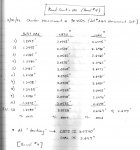memilanuk
Gold $$ Contributor
So... been using this method since shortly after @Alex Wheeler first posted it on here. Love it. Took me a little bit of finagling to figure out how to make it work with a Savage bolt, and a little more to deal with some of the peculiarities of a Bighorn Origin bolt, but I use it all the time on my .308s and 6.5 CM bolt guns. Works *awesome*.
But...
For some reason, I have not-so-good luck trying to use it on my .223 Rem bolt guns. Again, Savage (one PTA, and one old 10FP) and Bighorn (same Origin as for the 6.5 CM). All custom/aftermarket barrels. 28" Krieger 7tw on the PTA, with an ISSF 0.169" FB chamber, 28" Shilen 7tw on the 10FP with a "90VLD" chamber (their words, not mine, I disagree, but...) and whatever 'match' reamer the gunsmith used on the 26" Krieger 8 tw for the Origin.
Basically... I can't 'feel' when the bullet engages the rifling - almost like it's rubbing in the freebore area. Had the same problem with a number of different bullets - Berger 75 & 80 gn VLDs, Berger 82gn BTs, 85.5 gn Hybrids, etc. Not sure if I've tried any Hornady or Nosler in those as of yet. Good quality brass - Lapua, both neck turned and not, depending on the gun. *Pretty sure* my rounds are straight enough they shouldn't be rubbing in the FB... but I'll admit I haven't blown the dust off the concentricity gauge and checked.
Anyone else have difficulty making this technique work on smaller calibers? I've pretty much had to go back to my 'old school' method of using a Stoney Point OAL tool with the modified case. It works, but it's definitely less civilized
Any other suggestions?
But...
For some reason, I have not-so-good luck trying to use it on my .223 Rem bolt guns. Again, Savage (one PTA, and one old 10FP) and Bighorn (same Origin as for the 6.5 CM). All custom/aftermarket barrels. 28" Krieger 7tw on the PTA, with an ISSF 0.169" FB chamber, 28" Shilen 7tw on the 10FP with a "90VLD" chamber (their words, not mine, I disagree, but...) and whatever 'match' reamer the gunsmith used on the 26" Krieger 8 tw for the Origin.
Basically... I can't 'feel' when the bullet engages the rifling - almost like it's rubbing in the freebore area. Had the same problem with a number of different bullets - Berger 75 & 80 gn VLDs, Berger 82gn BTs, 85.5 gn Hybrids, etc. Not sure if I've tried any Hornady or Nosler in those as of yet. Good quality brass - Lapua, both neck turned and not, depending on the gun. *Pretty sure* my rounds are straight enough they shouldn't be rubbing in the FB... but I'll admit I haven't blown the dust off the concentricity gauge and checked.
Anyone else have difficulty making this technique work on smaller calibers? I've pretty much had to go back to my 'old school' method of using a Stoney Point OAL tool with the modified case. It works, but it's definitely less civilized
Any other suggestions?











